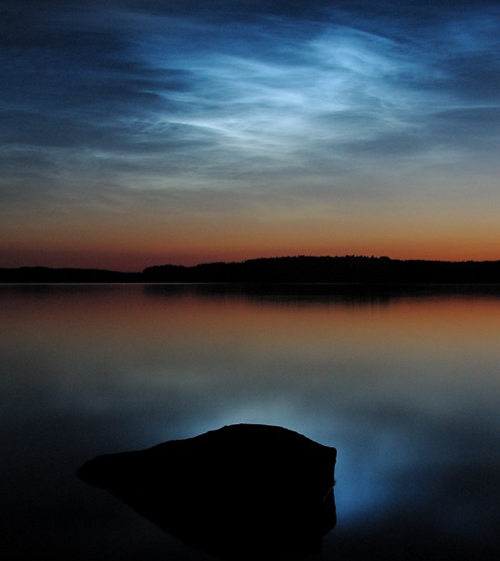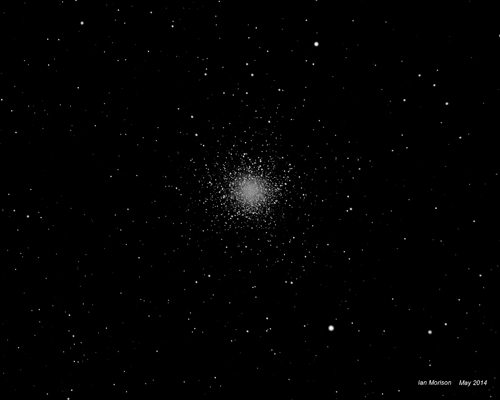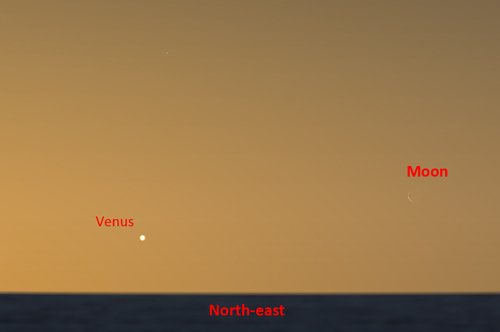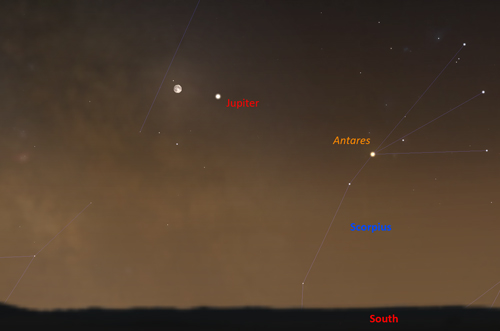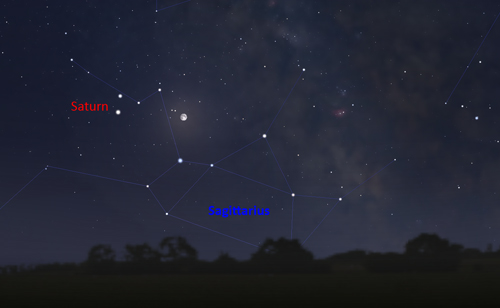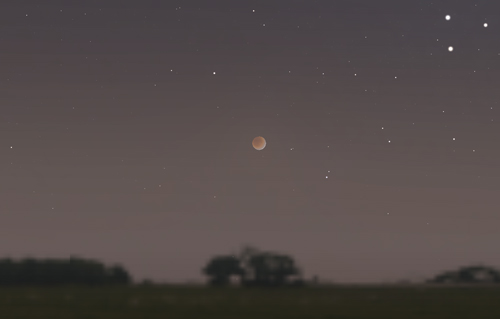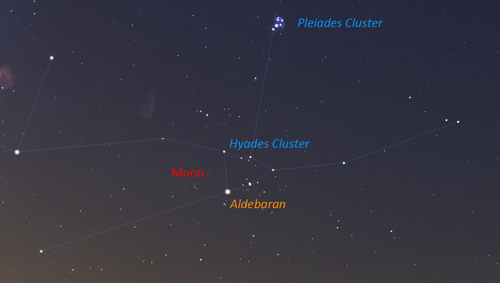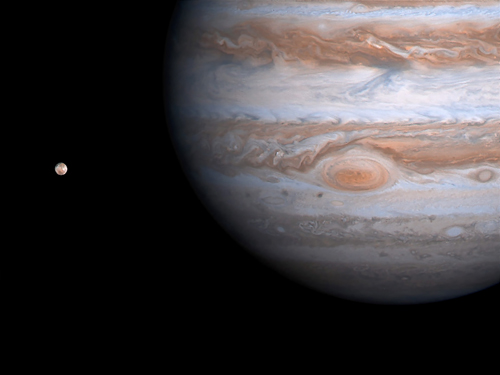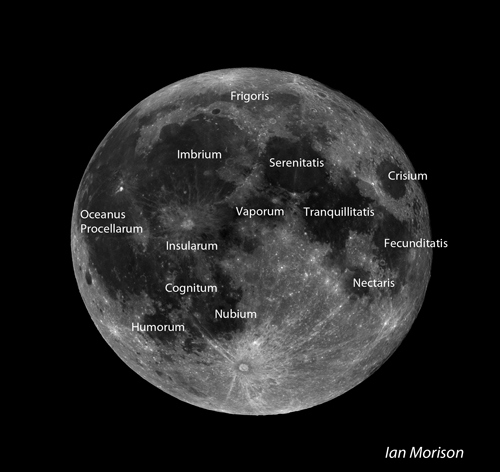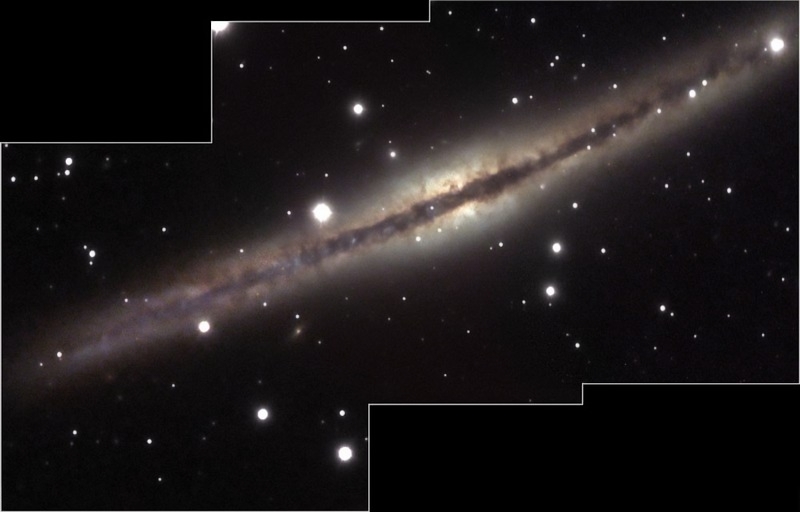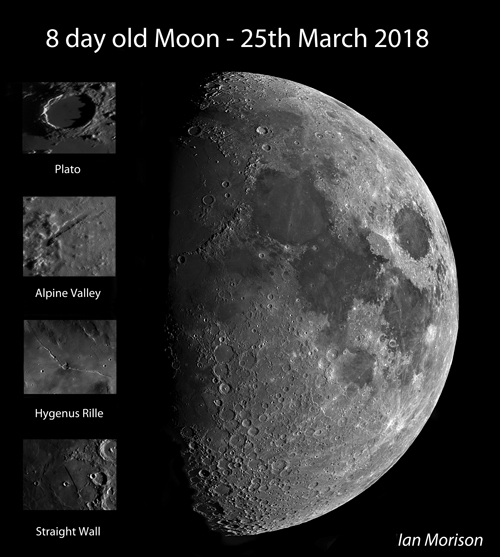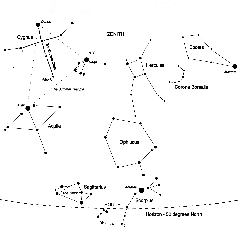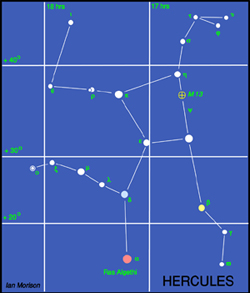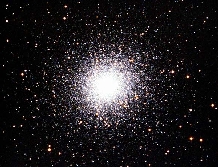The Night Sky July 2019
Compiled by Ian Morison
Note the partial eclipse of the Moon on the evening of the 16th July.
This page, updated monthly, will let you know some of the things that you can look out for in the night sky. It lists the phases of the Moon, where you will see the naked-eye planets and describes some of the prominent constellations in the night sky during the month.
New(ish)
The author's: Astronomy Digest
which, over time, will provide useful and, I hope, interesting articles for all amateur astronomers. A further aim is to update and add new material to link with the books recently published by Cambridge University Press and which are described on the home page of the digest. It now includes over 60 illustrated articles. This is now up and running following being hacked on the 26th June.Image of the Month
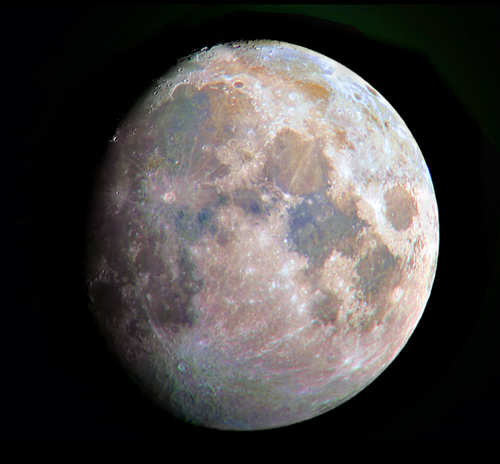
A colourfull Moon
We think of the Moon as simply being visible in (very dark) shades of grey. But this is not quite true, as there are some very subtle colour differences which can be brought out with a suitable imaging process as described in the Astronomy Digest. In fact, this image tells us a little about the Moon's surface geology, as the bluish colour of Mare Tranquillitatis indicates that the basalt lava contains more titanium (TiO2) than Mare Serenitatis up to its left which contains relatively more iron (FeO) giving it a redder colour. The southern portion of Mare Tranquillitatis contains the highest proportion of Titanium on the lunar surface at 4.4%.
The lunar map below made using visual observations by Lucien Rudaux shows that he must have had amazing vision to bring out the very subtle colours of the lunar surface. The agreement from Mare Tranquillitatis up and across to the crater Plato and the Sinus Iridum to its upper left is perfect.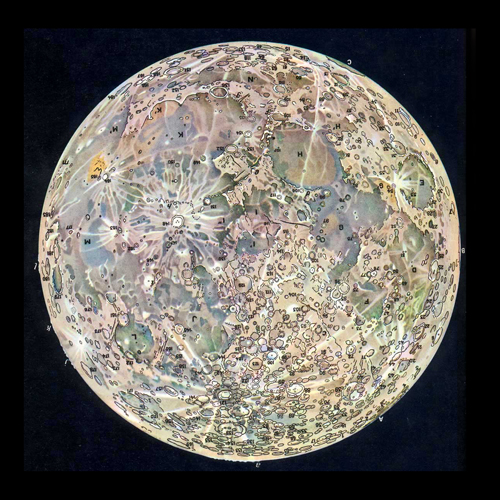
Lunar map drawn and coloured by Lucien Rudaux and printed in the Larrouse Encyclopedia of Astronomy in 1967.
Highlights of the Month
Early July: A very good time to spot Noctilucent Clouds!
Noctilucent clouds, also known as polar mesospheric clouds, are most commonly seen in the deep twilight towards the north from our latitude. They are the highest clouds in the atmosphere at heights of around 80 km or 50 miles. Normally too faint to be seen, they are visible when illuminated by sunlight from below the northern horizon whilst the lower parts of the atmosphere are in shadow. They are not fully understood and are increasing in frequencey, brightness and extent; some think that this might be due to climate change! So on a clear dark night as light is draining from the north western sky long after sunset take a look towards the north and you might just spot them!
July - Find the globular cluster in Hercules and spot the "Double-double" in Lyra
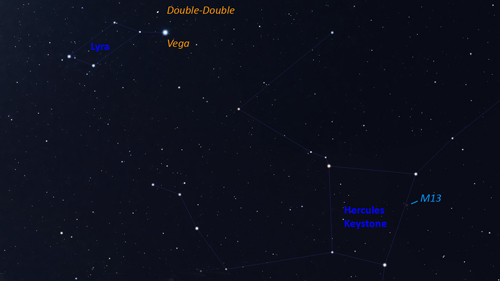
Use binoculars to find the globular cluster M13 in Hercules and the "Double-double" in Lyra
Image: Stellarium/IM
There are two very nice objects to spot with binoculars in the south-eastern sky well after dark this month. Two thirds of the way up the right hand side of the 4 stars that make up the "keystone" in the constellation Hercules is M13, the best globular cluster visible in the northern sky. The 15 minute exposure image on right was taken by the author using a 127 mm APO refractor and SBIG 8.3 megapixel CCD camera.
Just to the left of the bright star Vega in Lyra is the multiple star system Epsilon Lyrae often called the double-double. With binoculars a binary star is seen but, when observed with a telescope, each of these two stars is revealed to be a double star - hence the name!
July 1st - before dawn: Venus and a crescent Moon.
Given a very low horizon looking towards the northeast before dawn one should, if clear, be able to spot Venus lying over to the left of a very thin waning crescent Moon.
July 13th - late evening: Jupiter near the Moon.
In the late evening towards the south, Jupiter will be seen down to the lower right of the Moon, three days before full.
July 15th - around midnight: Saturn and the Moon
Looking south around midnight, Saturn will be seen over to the left of the Moon two days before full.
July 16th - after sunset: a partial eclipse of the Moon
Looking low in the southeast after sunset we might, if clear, be able to observe a partially eclipsed Moon. The partial eclipse will end around midnight BST.
July 28th - before dawn: a crescent waning Moon and the Hyades Cluster.
Before dawn on the 28th, a very thin crescent Moon will be seen to the left of the Hyades Cluster.
July: Look for the Great Red Spot on Jupiter
This list gives some of the best evening times during July to observe the Great Red Spot which should then lie on the central meridian of the planet. The times are in UT.
2nd 23:37 26th 23:25
7th 22:45 31st 22:33
12th 21:52
14th 23:31
Learn the Mare on the Moon.
Why not use the annotated image of the full Moon to learn the locations of the Moon's Mare. You can see some of them with your unaided eye and binoculars will enable you to spot them all.
NGC 891 imaged with the Faulkes Telescope
Galaxy NGC 891, imaged by Daniel Duggan.
This image was taken using the Faulkes Telescope North by Daniel Duggan - for some time a member of the Faulkes telescope team. NGC 891 is an edge-on spiral lying in the constellation Andromeda at a distance of 27 million light years. We think that this is very much as our own galaxy might look when seen edge-on.
Learn more about the Faulkes Telescopes and how schools can use them: Faulkes Telescope"
Observe the International Space Station

The International Space Station and Jules Verne passing behind the Lovell Telescope on April 1st 2008.
Image by Andrew Greenwood
Use the link below to find when the space station will be visible in the next few days. In general, the space station can be seen either in the hour or so before dawn or the hour or so after sunset - this is because it is dark and yet the Sun is not too far below the horizon so that it can light up the space station. As the orbit only just gets up the the latitude of the UK it will usually be seen to the south, and is only visible for a minute or so at each sighting. Note that as it is in low-earth orbit the sighting details vary quite considerably across the UK. The NASA website linked to below gives details for several cities in the UK. (Across the world too for foreign visitors to this web page.)
Note: I observed the ISS three times recently and was amazed as to how bright it has become.
Find details of sighting possibilities from your location from: Location Index
See where the space station is now: Current Position
The Moon

The Moon at 3rd Quarter. Image, by Ian Morison, taken with a 150mm Maksutov-Newtonian and Canon G7.
Just below the crator Plato seen near the top of the image is the mountain "Mons Piton". It casts a long shadow across the maria from which one can calculate its height - about 6800ft or 2250m.
| new moon | first quarter | full moon | third quarter |
|---|---|---|---|
| July 2nd | July 9th | July 16th | July 25th |
Some Lunar Images by Ian Morison, Jodrell Bank Observatory: Lunar Images
A World Record Lunar Image
To mark International Year of Astronomy, a team of British astronomers have made the largest lunar image in history and gained a place in the Guinness Book of Records! The whole image comprises 87.4 megapixels with a Moon diameter of 9,550 pixels. The resolution of ~0.4 arc seconds allows details as small as 1km across to be discerned! The superb quality of the image is shown by the detail below of Plato and the Alpine Valley. Craterlets are seen on the floor of Plato and the rille along the centre of the Alpine valley is clearly visible. The image quality is staggering! The team of Damian Peach, Pete lawrence, Dave Tyler, Bruce Kingsley, Nick Smith, Nick Howes, Trevor Little, David Mason, Mark and Lee Irvine with technical support from Ninian Boyle captured the video sequences from which 288 individual mozaic panes were produced. These were then stitched together to form the lunar image.
Please follow the link to the Lunar World Record website and it would be really great if you could donate to Sir Patrick Moore's chosen charity to either download a full resolution image or purchase a print.
The 8 day old Moon
This image was taken by the author on a night in March 2018 when the Moon was at an elevation of ~52 degrees and the seeing was excellent. This enabled the resolution of the image to be largely determined by the resolution of the 200 mm aperture telescope and the 3.75 micron pixel size of the Point Grey Chameleon 1.3 megapixel video camera. The use of a near infrared filter allowed imaging to take place before it was dark and also reduced the effects of atmospheric turbulence. The 'Drizzle' technique developed by the Hubble Space Telescope Institute (HSTI) was used to reduce the effective size of the camera's pixels to allow the image to be well sampled. Around 100 gigabytes of data, acquired over a 2 hour period, was processed to produce images of 54 overlapping areas of the Moon which were then combined to give the full lunar disk in the free 'stitching' program Microsoft ICE. A further HSTI development called 'deconvolution sharpening' was then applied to the image. The Moon's disk is ~6,900 pixels in height and has a resolution of 0.6 to 0.7 arc seconds. Interestingly, as seen in the inset image, the rille lying along the centre of the Alpine Valley is just discernable and this is only ~0.5 km wide! [Due to size limitations the large image is 2/3 full size.]
The Planets
Jupiter
Jupiter, shining initially at magnitude -2.6 and falling to -2.4, reached opposition on June 10th and is thus visible towards the south as darkness falls. Its angular size drops slightly from 45.5 to 43 arc seconds as the month progresses. Jupiter, in the southern part of Ophiuchus, is moving westwards in retrograde motion so moving towards Antares in Scorpius and will lie some 7 degrees up and to its left by month's end. A highlight gives the times when the Great Red Spot faces the Earth. Sadly it is heading towards the southernmost part of the ecliptic so, as it crosses the meridian, it will only have an elevation of ~14 degrees (from central UK). Atmospheric dispersion will thus take its toll and an atmospheric dispersion corrector would greatly help to improve our views of the giant planet.
Saturn
Saturn, comes into oppositions on July 9th shining at magnitude +0.1 during the month so crosses the meridian around 1 am BST. Its disk is ~18 arc seconds across and its rings - which are still nicely tilted from the line of sight - spanning some 42 arc seconds across. Sadly, now in Sagittarius and lying on the southern side of the milky way, it is at the lowest point of the ecliptic and will only reach an elevation of ~14 degrees. As with Jupiter, an atmospheric dispersion corrector will help improve our view.
Mercury
Mercury, might just be seen low in the west-northwest after sunset in the first few days of the month with a magnitude of 1.1 and an angular size of 9.4 arc seconds To spot it, one will need a very low horizon and binoculars could well be needed to reduce the Sun's background glare, but please do not use them until after the Sun has set.
Mars
Mars, remains at magnitude +1.8 all month and is still just visible low in the west-northwest after sunset. Mars crosses Cancer during the month and passes into Leo on the 29th. Mars sets some one hour after the Sun at the start of July (with an elevation at sunset of ~9 degrees) but less than half an hour by month's end - when it will be very difficult to spot. Its angular size falls from 3.7 to 3.5 arc seconds during the month so one will not be able to spot any details on its salmon-pink surface. Binoculars could well be needed to reduce the Sun's background glare, but please do not use them until after the Sun has set.
Venus
Venus with a magnitude of -3.9 rises less than one hour before the Sun at the start of the month with an angular size of 9.7 arc seconds but will be lost from our view around the 18th. Its elevation is only ~4 degrees at sunrise so a very low horizon just north of east is required and binoculars may well be needed to spot it through the Sun's glare - but please do not use them after the Sun has risen.
The Stars
The late evening July Sky
This map shows the constellations seen towards the south at about 10pm BST in mid July. The most prominent star, just a little west of South, is Arcturus in Bootes. It is the second (after Sirius) brightest star in the northern sky. High overhead towards the north (not shown on the chart) and up to the right of Arcturus lies Ursa Major with its prominent grouping of the Plough. As one moves southwards to the left of Bootes one first crosses the constellation Hercules with its magnificent globular cluster, M13, and then across the large but not prominent constellation Ophiucus until, low above the southern horizon lie Sagittarius and Scorpius. Those in the south of the UK - and even better in Southern Europe - will spot the bright red star Antares. Rising in the east is the beautiful region of the Milky Way containing both Cygnus and Lyra. Below is Aquilla. The three bright stars Deneb (in Cygnus), Vega (in Lyra) and Altair (in Aquila) make up the "Summer Triangle".
The constellation Ursa Major
The stars of the Plough, shown linked by the thicker lines in the chart above, form one of the most recognised star patterns in the sky. Also called the Big Dipper, after the soup ladles used by farmer's wives in America to serve soup to the farm workers at lunchtime, it forms part of the Great Bear constellation - not quite so easy to make out! The stars Merak and Dubhe form the pointers which will lead you to the Pole Star, and hence find North. The stars Alcor and Mizar form a naked eye double which repays observation in a small telescope as Mizar is then shown to be an easily resolved double star. A fainter reddish star forms a triangle with Alcor and Mizar.
Ursa Major contains many interesting "deep sky" objects. The brightest, listed in Messier's Catalogue, are shown on the chart, but there are many fainter galaxies in the region too. In the upper right of the constellation are a pair of interacting galaxies M81 and M82 shown in the image below. M82 is undergoing a major burst of star formation and hence called a "starburst galaxy". They can be seen together using a low power eyepiece on a small telescope.
Another, and very beautiful, galaxy is M101 which looks rather like a pinwheel firework, hence its other name the Pinwheel Galaxy. It was discovered in1781 and was a late entry to Messier's calalogue of nebulous objects. It is a type Sc spiral galaxy seen face on which is at a distance of about 24 million light years. Type Sc galaxies have a relativly small nucleus and open spiral arms. With an overall diameter of 170,000 light it is one of the largest spirals known (the Milky Way has a diameter of ~ 130,000 light years).
Though just outside the constellation boundary, M51 lies close to Alkaid, the leftmost star of the Plough. Also called the Whirlpool Galaxy it is being deformed by the passage of the smaller galaxy on the left. This is now gravitationally captured by M51 and the two will eventually merge. M51 lies at a distance of about 37 million light years and was the first galaxy in which spiral arms were seen. It was discovered by Charles Messier in 1773 and the spiral structure was observed by Lord Rosse in 1845 using the 72" reflector at Birr Castle in Ireland - for many years the largest telescope in the world.
Lying close to Merak is the planetary nebula M97 which is usually called the Owl Nebula due to its resemblance to an owl's face with two large eyes. It was first called this by Lord Rosse who drew it in 1848 - as shown in the image below right. Planetary nebulae ar the remnants of stars similar in size to our Sun. When all possible nuclear fusion processes are complete, the central core collpses down into a "white dwarf" star and the the outer parts of the star are blown off to form the surrounding nebula.
The constellation Hercules
Between the constellation Bootes and the bright star Vega in Lyra lies the constellation Hercules.The Red Giant star Alpha Herculis or Ras Algethi, its arabic name, is one of the largest stars known, with a diameter of around 500 times that of our Sun. In common with most giant stars it varies its size, changing in brightness as it does so from 3rd to 4th magnitude. Lying along one side of the "keystone" lies one of the wonders of the skies, the great globular cluster, M13. Just visible to the unaided eye on a dark clear night, it is easily seen through binoculars as a small ball of cotten wool about 1/3 the diameter of the full Moon. The brightness increases towards the centre where the concentration of stars is greatest. It is a most beautiful sight in a small telescope. It contains around 300,000 stars in a region of space 100 light years across, and is the brightest globular cluster that can be seen in the northern hemisphere.
The constellation Virgo
Virgo, in the south-east after sunset this month, is not one of the most prominent constellations, containing only one bright star, Spica, but is one of the largest and is very rewarding for those with "rich field" telescopes capable of seeing the many galaxies that lie within its boundaries. Spica is, in fact, an exceedingly close double star with the two B type stars orbiting each other every 4 days. Their total luminosity is 2000 times that of our Sun. In the upper right hand quadrant of Virgo lies the centre of the Virgo Cluster of galaxies. There are 13 galaxies in the Messier catalogue in this region, all of which can be seen with a small telescope. The brightest is the giant elliptical galaxy, M87, with a jet extending from its centre where there is almost certainly a massive black hole into which dust and gas are falling. This releases great amounts of energy which powers particles to reach speeds close to the speed of light forming the jet we see. M87 is also called VIRGO A as it is a very strong radio source.
Below Porrima and to the right of Spica lies M104, an 8th magnitude spiral galaxy about 30 million light years away from us. Its spiral arms are edge on to us so in a small telescope it appears as an elliptical galaxy. It is also known as the Sombrero Galaxy as it looks like a wide brimmed hat in long exposure photographs.
The constellations Lyra and Cygnus
This month the constellations Lyra and Cygnus are rising in the East as darkness falls with their bright stars Vega, in Lyra, and Deneb, in Cygnus, making up the "summer triangle" of bright stars with Altair in the constellation Aquila below. (see sky chart above)
Lyra
Lyra is dominated by its brightest star Vega, the fifth brightest star in the sky. It is a blue-white star having a magnitude of 0.03, and lies 26 light years away. It weighs three times more than the Sun and is about 50 times brighter. It is thus burning up its nuclear fuel at a greater rate than the Sun and so will shine for a correspondingly shorter time. Vega is much younger than the Sun, perhaps only a few hundred million years old, and is surrounded by a cold,dark disc of dust in which an embryonic solar system is being formed!
There is a lovely double star called Epsilon Lyrae up and to the left of Vega. A pair of binoculars will show them up easily - you might even see them both with your unaided eye. In fact a telescope, provided the atmosphere is calm, shows that each of the two stars that you can see is a double star as well so it is called the double double!
Between Beta and Gamma Lyra lies a beautiful object called the Ring Nebula. It is the 57th object in the Messier Catalogue and so is also called M57. Such objects are called planetary nebulae as in a telescope they show a disc, rather like a planet. But in fact they are the remnants of stars, similar to our Sun, that have come to the end of their life and have blown off a shell of dust and gas around them. The Ring Nebula looks like a greenish smoke ring in a small telescope, but is not as impressive as it is shown in photographs in which you can also see the faint central "white dwarf" star which is the core of the original star which has collapsed down to about the size of the Earth. Still very hot this shines with a blue-white colour, but is cooling down and will eventually become dark and invisible - a "black dwarf"! Do click on the image below to see the large version - its wonderful!
M56 is an 8th magnitude Globular Cluster visible in binoculars roughly half way between Alberio (the head of the Swan) and Gamma Lyrae. It is 33,000 light years away and has a diameter of about 60 light years. It was first seen by Charles Messier in 1779 and became the 56th entry into his catalogue.
Cygnus
Cygnus, the Swan, is sometimes called the "Northern Cross" as it has a distinctive cross shape, but we normally think of it as a flying Swan. Deneb,the arabic word for "tail", is a 1.3 magnitude star which marks the tail of the swan. It is nearly 2000 light years away and appears so bright only because it gives out around 80,000 times as much light as our Sun. In fact if Deneb where as close as the brightest star in the northern sky, Sirius, it would appear as brilliant as the half moon and the sky would never be really dark when it was above the horizon!
The star, Albireo, which marks the head of the Swan is much fainter, but a beautiful sight in a small telescope. This shows that Albireo is made of two stars, amber and blue-green, which provide a wonderful colour contrast. With magnitudes 3.1 and 5.1 they are regarded as the most beautiful double star that can be seen in the sky.
Cygnus lies along the line of the Milky Way, the disk of our own Galaxy, and provides a wealth of stars and clusters to observe. Just to the left of the line joining Deneb and Sadr, the star at the centre of the outstretched wings, you may, under very clear dark skys, see a region which is darker than the surroundings. This is called the Cygnus Rift and is caused by the obscuration of light from distant stars by a lane of dust in our local spiral arm. the dust comes from elements such as carbon which have been built up in stars and ejected into space in explosions that give rise to objects such as the planetary nebula M57 described above.
Deneb,the arabic word for "tail", is a 1.3 magnitude star which marks the tail of the swan. It is nearly 2000 light years away and appears so bright only because it gives out around 80,000 times as much light as our Sun. In fact if Deneb where as close as the brightest star in the northern sky, Sirius, it would appear as brilliant as the half moon and the sky would never be really dark when it was above the horizon!
There is a beautiful region of nebulosity up and to the left of Deneb which is visible with binoculars in a very dark and clear sky. Photographs show an outline that looks like North America - hence its name the North America Nebula. Just to its right is a less bright region that looks like a Pelican, with a long beak and dark eye, so not surprisingly this is called the Pelican Nebula. The photograph below shows them well.
Brocchi's Cluster An easy object to spot with binoculars in Gygnus is "Brocchi's Cluster", often called "The Coathanger",although it appears upside down in the sky! Follow down the neck of the swan to the star Alberio, then sweep down and to its lower left. You should easily spot it against the dark dust lane behind.


